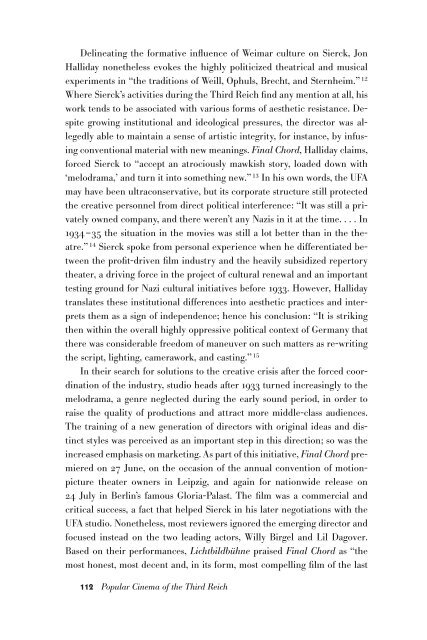Create successful ePaper yourself
Turn your PDF publications into a flip-book with our unique Google optimized e-Paper software.
Delineating the formative influence of Weimar culture on Sierck, Jon<br />
Halliday nonetheless evokes the highly politicized theatrical and musical<br />
experiments in “the traditions of Weill, Ophuls, Brecht, and Sternheim.” 12<br />
Where Sierck’s activities during the Third Reich find any mention at all, his<br />
work tends to be associated with various forms of aesthetic resistance. Despite<br />
growing institutional and ideological pressures, the director was allegedly<br />
able to maintain a sense of artistic integrity, for instance, by infusing<br />
conventional material with new meanings. Final Chord, Halliday claims,<br />
forced Sierck to “accept an atrociously mawkish story, loaded down with<br />
‘melodrama,’ and turn it into something new.” 13 In his own words, the UFA<br />
may have been ultraconservative, but its corporate structure still protected<br />
the creative personnel from direct political interference: “It was still a privately<br />
owned company, and there weren’t any Nazis in it at the time. . . . In<br />
1934–35 the situation in the movies was still a lot better than in the theatre.”<br />
14 Sierck spoke from personal experience when he differentiated between<br />
the profit-driven film industry and the heavily subsidized repertory<br />
theater, a driving force in the project of cultural renewal and an important<br />
testing ground for Nazi cultural initiatives before 1933. However, Halliday<br />
translates these institutional differences into aesthetic practices and interprets<br />
them as a sign of independence; hence his conclusion: “It is striking<br />
then within the overall highly oppressive political context of Germany that<br />
there was considerable freedom of maneuver on such matters as re-writing<br />
the script, lighting, camerawork, and casting.” 15<br />
In their search for solutions to the creative crisis after the forced coordination<br />
of the industry, studio heads after 1933 turned increasingly to the<br />
melodrama, a genre neglected during the early sound period, in order to<br />
raise the quality of productions and attract more middle-class audiences.<br />
The training of a new generation of directors with original ideas and distinct<br />
styles was perceived as an important step in this direction; so was the<br />
increased emphasis on marketing. As part of this initiative, Final Chord premiered<br />
on 27 June, on the occasion of the annual convention of motionpicture<br />
theater owners in Leipzig, and again for nationwide release on<br />
24 July in Berlin’s famous Gloria-Palast. The film was a commercial and<br />
critical success, a fact that helped Sierck in his later negotiations with the<br />
UFA studio. Nonetheless, most reviewers ignored the emerging director and<br />
focused instead on the two leading actors, Willy Birgel and Lil Dagover.<br />
Based on their performances, Lichtbildbühne praised Final Chord as “the<br />
most honest, most decent and, in its form, most compelling film of the last<br />
112 Popular Cinema of the Third Reich

















